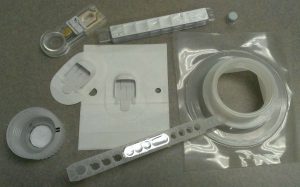
Why Implement Heat Sealing in the Manufacture of Wearable Medical Devices?
Wearable medical devices are taking off.
From glucose monitors to medicine dispensing pumps, patients’ ability to comfortably and consistently wear medical devices on their bodies is expanding treatment options and improving the patients’ quality of life while treating many medical conditions. Thanks to new technologies – adhesive patch technologies, in particular – experts predict that the wearable medical device market will grow to $27.8 billion by 2022.
Importantly, most of these devices’ underlying technology remains largely the same. New advances in these technologies have made these devices smaller and much easier for patients to wear. New technology means wearable medical devices now have longer-lasting batteries, more efficient electronics, and more comfortable adhesives.
For medical equipment manufacturers, patient comfort is one of the chief concerns when modifying existing product designs to incorporate new technologies. When patients find their wearable devices uncomfortable, they will choose the devices that are made by manufactures that are more comfortable or contemplate not complying with medical directives – even life-saving ones.
Assembly Technologies for Manufacturing Wearable Medical Devices
In the past, adhesive patches for medical devices has relied on one of two technologies.
- Ultrasonic Welding: This welding process uses high-frequency (and high-pitched) vibration to connect medical devices to their adhesive patch components. It is a well-established technology that produces consistent results, but comes with important drawbacks. Most importantly, patients report that these adhesive patch devices built with ultrasonic welding techniques tend to feel uncomfortable because of the sharp edges created during the ultrasonic welding process. The adhesive patch welded joints on the device feel sharp to the patients’ skin.
- Glue: Many medical equipment manufacturers use glue to connect device components. While glue is more comfortable than ultrasonic welding, it presents challenges during the manufacturing process. In particular, even the most advanced glues need to be clamped and require significant time to set, which adds minutes to a process that would otherwise take mere seconds. In a high-volume manufacturing setting, this can lead to enormous productivity costs.
Medical equipment manufacturers are often surprised to discover that heat sealing is an easily integrated technology for quickly and consistently producing high volumes of wearable devices. As a third option, it addresses the shortfalls of the two aforementioned assembly technologies.
Heat Sealing Increases Patient Comfort
When compared to the use of glue or ultrasonic welding, heat sealing offers a fast and reliable method of welding adhesives patches to medical devices. The process accurately seals the adhesive patch onto the body of the thermoplastic device by applying localized heat and pressure to wick the plastic material into the adhesive patches woven material producing a tight, powerful weld.
Because the bond relies on a controlled flow of the plastic material into the adhesive patch, it has creates NO sharp edges. Heat sealing bonds are smooth to the touch and almost invisible to the patient in the finished product. Patients report these devices to be more comfortable and easier to regularly use than products manufactured using ultrasonic welding techniques.
On the manufacturing side, the heat sealing process takes mere seconds to complete. A properly calibrated thermal press can heat seal 10-30 pieces per minute. This is exponentially more time-efficient than gluing, which takes minutes to set per individual component. Manufacturers who take advantage of this technology can expect huge boosts in productivity and quality on the factory floor.